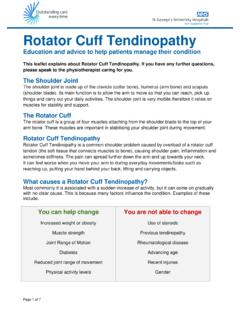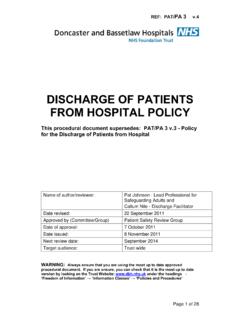Transcription of Guidelines for Patients Requiring ... - St George's Hospital
1 Page 1 of 25 Guidelines for Patients Requiring One to One Observation The Trust strives to ensure equality of opportunity for all, both as a major employer and as a provider of health care. This procedural document has been equality impact assessed to ensure fairness and consistency for all those covered by it regardless of their individual differences and the results are shown in Appendix C. Policy Profile Version: Author: Lesley Law, Matron Updated by Paul Silke, Head of Nursing, Workforce Executive sponsor: Avey Bhatia, Chief Nurse and DIPC Target audience: All trust staff Date issued: April 2017 Review date: April 2019 Approval Approval Committee: Nursing Board Date: 30 March 2017 Document History Version Date Review date Reason for change Draft 3 2011 May 2016 To update policy. Draft March 2017 To update policy. To add in paediatric care Page 2 of 25 Contents Paragraph Page Executive Summary 3 1 Introduction 3 2 Purpose 4 3 Definitions 4 4 Scope 4 5 Roles and responsibilities 5 6 Process 6 7 Booking Request 7 8 deprivation of liberty 7 9 Patients Requiring psychiatric care 8 10 Prisoners within Hospital premises 10 11 Implementation and dissemination 11 12 Monitoring compliance 12 Appendices A Level of observation risk assessment 13 B Pathway for requesting 1:1 RMN/HCSW 15 C Equality Impact Assessment 16 D Procedural Document Checklist 17 E Mittens risk assessment 19 F Bed Rails risk assessment 20 G Nursing Agency Assurance Authorisation: Form 1 (office hours) 22 H Nursing Agency Assurance Authorisation: Form 1 (out of office hours) 24 Page 3 of 25 Executive Summary The request for a registered nurse or health care support worker to provide one to one nursing is a complex issue.
2 The aim of one to one nursing is to provide continuous observation for an individual patient for a period of time during acute physical or mental illness. This policy will clarify the booking process and approval of one to one nursing at ward level as well as giving an overview of patient groups who may require this intensive observational nursing input. This policy will act as a guide to all staff when requesting one to one nursing for continuous observation and identify the procedure to be followed. This policy is for children and adults and covers all bed based services within the trust including Queen Mary s Roehampton. 1. Introduction The decision to use one to one nursing is based on a risk assessment of the patient s physical and/or mental state at the time of the assessment and must be repeated at least every 24 hours. There are many circumstances where Patients may require one to one nursing from either a registered nurse or healthcare support worker and will include the following: The patient is acutely physically unwell and/or requires frequent observations The patient is acutely mentally ill and/or at immediate risk of serious self-harm/suicide The patient is likely to wander or abscond and is at risk to him/herself The patient is confused/agitated/aggressive /violent towards others The patient has been assessed as being at High risk of falls or has had multiple falls during Hospital admission.
3 The patient requires constant observations to prevent self-harm due to cognitive impairment. The patient is undergoing investigations where normal medication is withheld, increasing the risk of a medical emergency ( : video telemetry) The patient is assessed as being at risk of falling or has a history of falls. The patient requires constant observation to prevent self harm due to age and reduced cognitive ability The patient is undergoing investigations where normal medication is withheld, increasing the risk of a medical emergency ( : video telemetry) This list is not exhaustive and each patient needs to be considered on an individual basis. The ward nursing rosters are planned in advance with the aim to provide the best possible skill mix, ensure patient safety and to take into account, where possible, fluctuations in patient dependency and workload. However there are occasions listed above where the need for one to one nursing is required and it is this group of Patients this policy refers to.
4 This document does not refer to intensive or critical care areas where one to one nursing is well established, unless a registered mental health nurse is required. In the event of an increase in workload Requiring an increased level of staff beyond the capacity of the nursing establishment, Page 4 of 25 permission must be sought from the Matron/Head of Nursing/Divisional Director of Nursing for that area. This applies to all ward areas within St George s Hospital and Queen Mary s Roehampton. 2. Purpose The purpose of this document is to 1. Clarify the booking and approval process for 1:1 nursing care both in core working hours and outside core hours for those Patients who require an increased level of supervision which cannot be provided by daily nursing establishments. 2. To clarify the cohort of Patients deemed appropriate for this increased level of supervision.
5 3. To clarify the risk assessment process for this group of Patients . 4. To ensure that the following controls and safety measures have been considered and/or in place before and during 1:1 nursing Moving or locating the patient closer to the nurses station for observation or consider a side room to reduce stimulation and help towards creating a restful environment or if they are causing a disturbance to other Patients . If the patient is nursed in a side room it is imperative that the patient is not left unsupervised at any time. Using patient safety equipment to lower the risk to the patient lowering the bed. Using adjacent ward staff if available to support Patients in need of closer supervision Ensure that patient s surroundings are safe. Complete a Level of Observation Risk Assessment which can be found on the Trust Intranet and at the end of this policy. Develop an appropriate care plan which is regularly reviewed 3.
6 Definitions One to one nursing or continuous observation are terms used for a registered nurse or health care support worker whose role it is to provide one to one nursing or observation care to an individual patient for a period of time. This nurse is often referred to as a nurse special. A Level of Observational Risk Assessment (appendix 1) will assist in the decision process to determine whether a registered adult or child nurse (RN), registered mental health nurse (RMN), Registered Nurse Learning Disabilities (RNLD) or a healthcare support worker (HCSW) is appropriate to provide this care. It remains the responsibility of the nurse in charge of the ward or department to oversee the care provided Mental Capacity The ability to understand and make a decision when it needs to be made is called mental capacity . deprivation of liberty (DOLS) this applies when the person is under continuous supervision control and is not free to leave, and the person lacks capacity to consent to these arrangements 4.
7 Scope This policy applies to all staff (temporary and permanent) working in any of the locations registered by St. George s University Hospitals NHS Foundation Trust with the Care Quality Commission (CQC) to provide regulated activities. Locations are not necessarily Page 5 of 25 geographically based or determined. Therefore, the term locations does not just refer to Trust buildings; it is the term used by the CQC to describe the hub of operations for a service or range of services and so includes all activities being performed in the course of performing one s role. 5. Roles and Responsibilities The Chief Executive is accountable to the Trust Board for ensuring that there are policies and procedures in place for effective patient care. The Chief Nurse and Chief Operating Officer are with the Medical Director accountable to the Chief Executive for the strategic development of governance, risk management and patient safety.
8 The Divisional Directors of Nursing and Governance are responsible for ensuring that, within their areas of responsibility (Division and directorate respectively), staff are aware of, and comply with the processes for assuring sound governance. They are also responsible for setting safe staffing levels in wards/departments and adequate leadership to enable compliance with this policy. Matrons/Heads of Nursing and Ward/departmental Sister/Charge Nurses have the responsibility for ensuring that, within their areas of responsibility a safe environment is maintained for Patients , by ensuring compliance with this policy. They are responsible for ensuring that all Patients are managed in an appropriate setting and that 1:1 observation nursing is instigated following an appropriate Level of Specialling Risk Assessment (adult), and that the on-going need for one to one observation nursing is assessed on a daily basis.
9 The registered nurse assigned to provide one to one continuous observation for an individual patient is responsible for: engaging and interacting with the patient whenever the opportunity arises monitoring the patient s behaviour and documenting and reporting any changes in behaviour or condition the recording, documentation and reporting of vital signs. ensuring that the patient has adequate appropriate nutrition and hydration. ensuring that the patient has taken all prescribed medication. providing assistance with personal care. Any other appropriate care or assistance as needed (ie: play therapy/distraction for children The health care assistant assigned to provide one to one continuous observation for an individual patient is responsible for the following under supervision and guidance of the registered nurse in charge of the ward or bay of Patients : Engaging and interacting with the patient whenever the opportunity arises monitoring and reporting any changes in behaviour or condition to the registered nurse Recording and reporting of vital signs under supervision of registered nurse Ensuring the patient has adequate nutrition and hydration Providing assistance with personal care Any other appropriate care or assistance as needed (ie.))
10 Play therapy/distraction for children Will have completed the Trust training in one to one specialising Page 6 of 25 The Adult Safeguarding Lead Nurse is responsible for giving advice about deprivation of liberty . 6. Process When the sister/charge nurse or the nurse in charge of the shift has identified that a patient may require one to one observation he/she will: Ensure all alternative strategies to manage the individual patient have been exhausted. Establish if additional assistance can be sought from the existing workforce by reallocation of staff. Complete the appropriate risk assessment (appendix A) and escalate to the Matron/ Head of Nursing or night practitioner/site team on Bleep 6007. Consider what competencies are required for safe care of the individual patient is a Registered adult or child Nurse RN, Registered Mental Health Nurse RMN or a Healthcare Support Worker required?
















